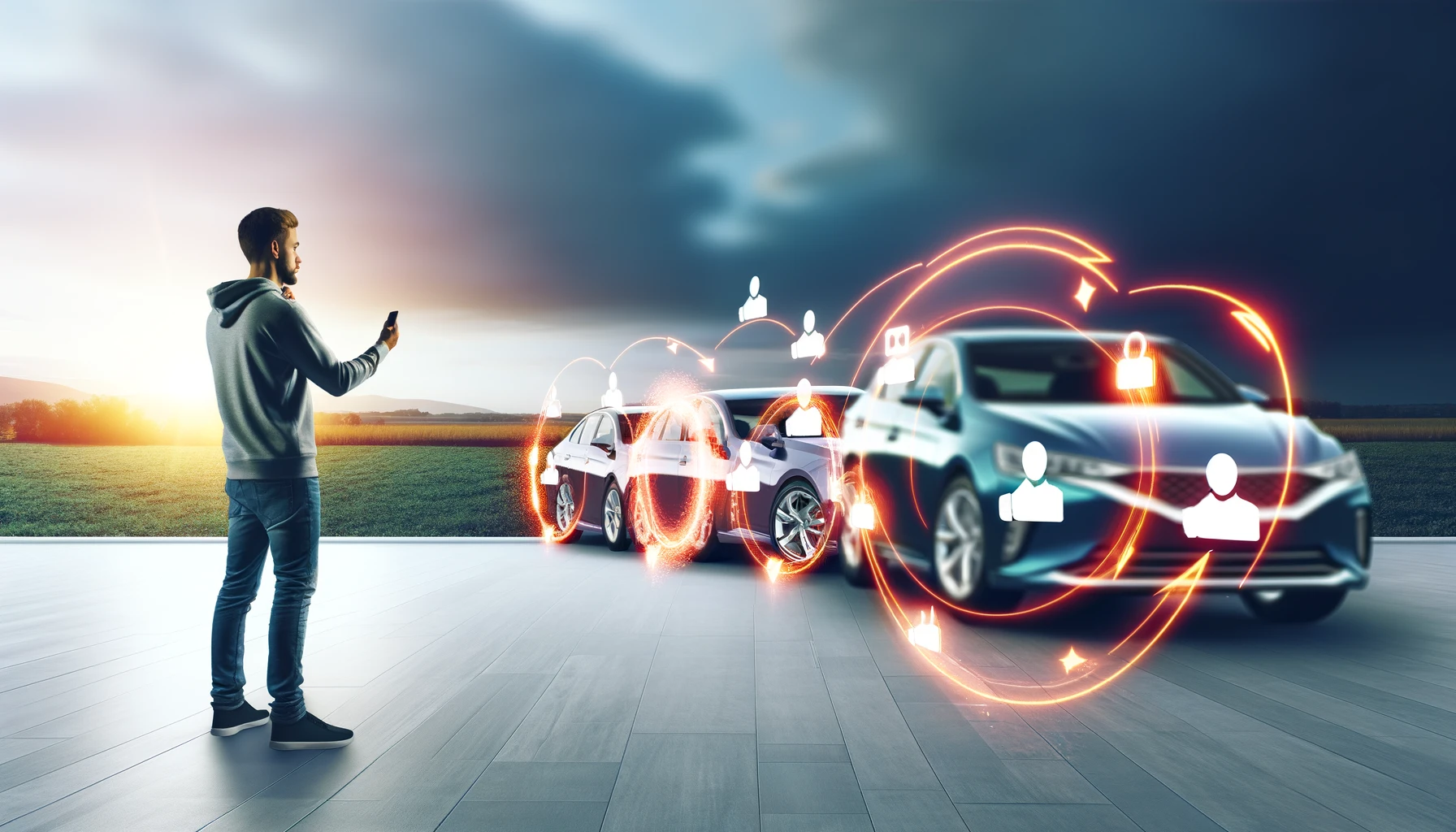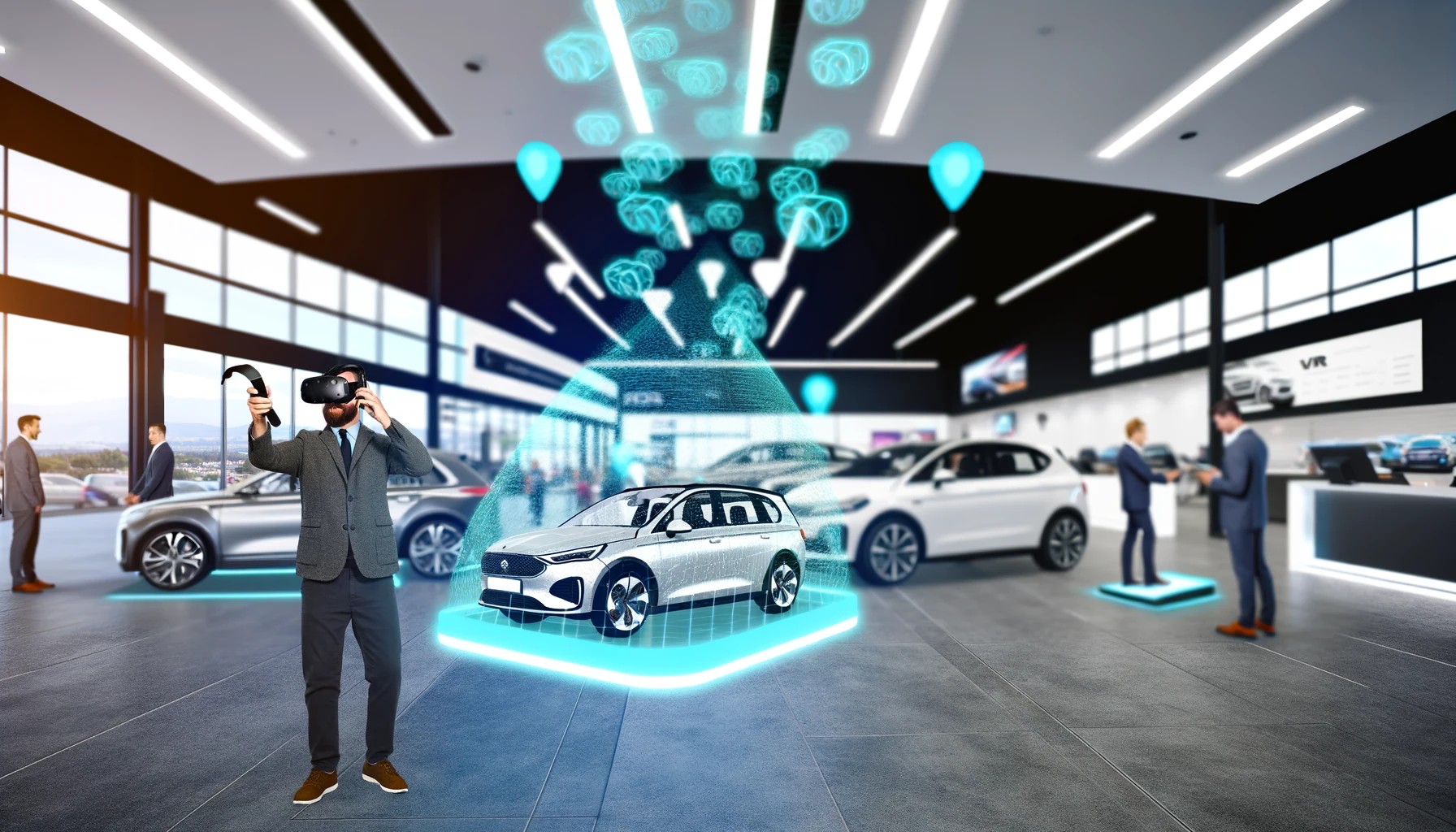
Driving Sales Forward 12 Essential Marketing Strategies for Car Dealerships
March 22, 2024
In the dynamic world of automotive sales, the key to differentiation and success lies in a dealership's ability to adapt to and leverage the latest marketing innovations.
As consumer behaviors shift and technological advancements redefine the marketplace, relying solely on traditional marketing methods is no longer viable.
Today, dealerships are tasked with crafting a marketing strategy that embraces digital transformation and creates immersive, memorable experiences for potential buyers.
"12 Essential Dealership Marketing Strategies for Accelerating Car Sales in the Digital Era" is designed to guide you through a comprehensive array of the BEST marketing strategies for car dealerships — from the proven power of social media and the personalized touch of email marketing to the immersive potential of virtual reality.
This article aims to equip your dealership with the insights and tools necessary to implement each strategy effectively, ensuring you can connect with customers, build durable relationships, and significantly boost your sales figures.
Whether your goal is to refine your approach to digital ads, elevate customer engagement levels, or pioneer new tech-based marketing initiatives, this guide is your roadmap to navigating the intricate marketing terrain and securing your dealership's prosperity.
Jump to Section:
1. Utilizing Social Media Platforms
Social media platforms represent a cornerstone in modern dealership marketing strategies, offering a direct line of communication to a vast audience with diverse interests and needs. Social media's inherent versatility and broad reach make it an indispensable tool for dealerships aiming to enhance brand visibility, engage with potential customers, and foster community loyalty. Here, we delve into the intricacies of effectively utilizing social media platforms to achieve these goals.

Platform Selection and Profile Optimization
The first step in harnessing the power of social media is selecting the platforms that align best with your dealership’s target audience. While Facebook, Instagram, and Twitter are universally recognized for their wide user bases, platforms like LinkedIn can be invaluable for B2B relationships, and TikTok offers access to a younger demographic.
- Facebook remains a staple for its extensive user base and sophisticated advertising tools. It’s ideal for sharing detailed content, customer testimonials, and service updates.
- Instagram excels in visual storytelling, perfect for showcasing high-quality images and videos of your inventory or offering glimpses into dealership events.
- Twitter is suited for real-time engagement and short, impactful messages, making it an excellent platform for news updates, industry insights, and customer service interactions.
- LinkedIn can help establish professional connections and share industry-related content, reinforcing your dealership's expertise and credibility.
- TikTok and similar platforms are on the rise, offering creative ways to reach and engage with a younger audience through short, entertaining videos.
Once platforms are chosen, it is crucial to optimize your profiles with detailed information about your dealership, including contact details, location, and services offered. High-quality profile pictures, cover images, and a consistent posting schedule enhance your social media presence.
Content Strategy and Engagement
A robust content strategy is essential for maintaining an active and engaging social media presence. This strategy should encompass a variety of content types and posting frequencies tailored to each platform's unique audience and format.
- Educational Content: Share insights about vehicle maintenance, buying tips, or industry trends to establish your dealership as a knowledgeable authority.
- Showcase Inventory: Regularly post high-quality photos and videos of vehicles in your inventory, highlighting key features, specials, and promotions.
- Customer Testimonials and Reviews: Sharing positive experiences from satisfied customers builds trust and credibility with your audience.
- Behind-the-Scenes Content: Give your audience a glimpse into your dealership's day-to-day operations, fostering a sense of community and transparency.
- Interactive Posts: Engage your audience with polls, quizzes, and questions to encourage interaction and feedback and provide valuable insights into their preferences and behaviors.
Active engagement is crucial. Respond promptly to comments, messages, and reviews, addressing positive feedback and resolving any customer concerns or issues. This proactive engagement demonstrates your commitment to customer satisfaction and helps build strong, loyal relationships.
Leveraged Advertising and Analytics
Social media platforms offer powerful advertising tools for precise targeting based on demographics, interests, behaviors, and more. Investing in targeted ads can significantly increase your reach and bring your dealership to the attention of potential customers actively seeking your products or services.
Use the platforms' analytics tools to monitor the performance of your posts and ads, gaining insights into engagement rates, audience growth, and the effectiveness of your content strategy.
"Regularly adjust your approach based on these analytics to refine your targeting, content, and engagement strategies, ensuring your social media efforts contribute effectively to your dealership's marketing goals."
In conclusion, effectively utilizing social media platforms requires a strategic approach. This starts with selecting and optimizing profiles on suitable platforms, developing a diverse and engaging content strategy, actively engaging with the community, and leveraging targeted advertising and analytics. By committing to these practices, dealerships can significantly enhance their online presence, attract and retain customers, and drive sales in today's digital landscape.
2. The Power of Email Marketing
As a dealership marketing strategy, the Power of Email Marketing leverages the direct and personalized communication channel with potential and existing customers. It's a multifaceted approach that combines the precision of targeting with the richness of content, enabling dealerships to foster relationships, promote offerings, and guide customers through the buying journey. Here's a detailed exploration of how to implement and maximize the effectiveness of email marketing within a dealership context:

Building a Targeted Email List
- Customer Data Integration: Integrate email collection into every customer touchpoint, such as sales inquiries, service appointments, and website interactions. Utilize forms with opt-in checkboxes to ensure compliance with data protection regulations.
- Segmentation: Segment your email list based on various criteria, such as purchase history, vehicle preferences, service history, and engagement levels. Segmentation enables tailored communication strategies that resonate with different audience segments.
- Lead Magnets: Offer valuable resources such as buying guides, maintenance tips, or exclusive offers in exchange for email subscriptions. Lead magnets grow your list and attract potential customers interested in your products and services.
Crafting Personalized Email Content
- Welcome Series: Send welcome emails to new subscribers introducing your dealership, sharing your unique selling propositions, and guiding them on what to expect from your emails.
- Newsletters: Regular newsletters can update subscribers on the latest vehicle models, dealership events, and industry news. To keep engagement high, incorporate a mix of content that educates, entertains, and informs.
- Promotions and Offers: Tailored promotions and exclusive services, accessories, or vehicle offers can drive sales and service appointments. Personalize these offers based on the recipient's interests and previous interactions with your dealership.
- Educational Content: Provide value through educational content that helps your audience make informed decisions. Topics can range from vehicle maintenance tips to new automotive technology insights.
Email Marketing Best Practices
- Responsive Design: Ensure your emails are mobile-friendly, considering a significant portion of users access their emails on smartphones. Use responsive templates that adapt to various screen sizes for optimal readability.
- A/B Testing: Continuously test elements such as subject lines, email copy, calls-to-action (CTAs), and send times to determine what works best with your audience and improve future campaigns.
- Automation and Drip Campaigns: Use marketing automation tools to create drip campaigns that nurture leads over time. These campaigns automatically send emails based on the recipient's specific triggers or actions.
- Analytics and Adjustments: Monitor key performance indicators (KPIs) such as open rates, click-through rates (CTR), conversion rates, and unsubscribe rates to gauge the effectiveness of your campaigns. Use these insights to refine your strategy and improve engagement and conversions.
Compliance and Ethical Considerations
Adhere to Regulations: Ensure compliance with email marketing laws and regulations such as the CAN-SPAM Act in the United States or GDPR in Europe. Legal compliance includes obtaining explicit consent to send emails, providing a straightforward way to unsubscribe, and being transparent about your identity.
"Privacy and Data Protection: Respect your subscribers' privacy and data by securely storing their information and using it responsibly. Respecting privacy builds trust and maintains a positive relationship with your audience."
In conclusion, email marketing offers dealerships a powerful tool to connect with their audience personally, build lasting relationships, and drive business goals. By carefully creating a targeted email list, crafting personalized and valuable content, adhering to best practices, and continuously optimizing based on data-driven insights, dealerships can maximize the impact of their email marketing efforts.
3. Creating Engaging Content
Creating Engaging Content as a dealership marketing strategy is a multifaceted approach to building brand authority, engaging with potential and existing customers, and driving traffic to your dealership’s digital platforms. Engaging content helps attract attention and nurtures a loyal community around your brand. Here’s a detailed exploration of how dealerships can implement a robust content creation strategy:

Understanding Your Audience
- Audience Research: Begin with thorough research to understand your target audience's needs, interests, and pain points. Utilize surveys, social media interactions, and customer feedback to gather insights.
- Persona Development: Create buyer personas representing your typical customers. These personas will guide your content creation, ensuring it resonates with and is relevant to your audience.
Content Strategy Development
- Content Pillars: Establish content pillars that align with your dealership’s values, audience interests, and business objectives. These include vehicle maintenance, automotive technology, car-buying tips, and community events.
- Content Calendar: Plan your content with a content calendar. Creators should schedule posts and videos around key automotive events, product launches, and seasonal activities to keep content timely and relevant.
Types of Engaging Content
- Blog Posts: Write informative, engaging, and SEO-friendly blog posts that answer common questions, provide insights into car buying processes, and offer vehicle maintenance tips. Use internal and external links to improve SEO and user experience.
- Videos: Produce videos that showcase vehicle features, customer testimonials, behind-the-scenes looks at dealership operations, and DIY maintenance tips. Videos can range from professionally produced to simple, authentic clips shot on a smartphone.
- Infographics and Visual Content: Create infographics and other visual content to explain complex automotive topics simply and engagingly. These are highly shareable and can help attract attention to social media.
- Interactive Content: Content creators should leverage quizzes, polls, and videos to engage users actively. Interactive content can increase engagement rates and provide valuable insights into your audience’s preferences.
Distribution and Promotion
- Social Media: Share your content across social media platforms where your audience is active. Tailor the message and format to fit each platform’s unique environment and user expectations.
- Email Marketing: Integrate your content into your email marketing campaigns. Share your latest blog posts or videos with your email subscribers to drive traffic to your site.
- Paid Promotion: Consider using paid advertising to amplify the reach of your most valuable content pieces. Target your ads to reach new audiences likely interested in your content.
Measuring Success
- Analytics: Use web and social analytics tools to track the performance of your content. Metrics to monitor include page views, time on the page, social shares, and conversion rates.
- Feedback and Adjustments: Collect feedback through comments, social media interactions, and direct customer feedback. Use this information to refine your content strategy and focus on what works best.
Best Practices for Creating Engaging Content
- Consistency: Maintain a consistent posting schedule to keep your audience engaged and to build anticipation for your next piece of content.
- Quality Over Quantity: Focus on producing high-quality content that provides value to your audience rather than trying to publish as much content as possible.
- SEO Optimization: Optimize your content for search engines to increase visibility. Include relevant keywords, meta descriptions, and alt text for images.
- Authenticity: Keep your brand voice authentic and genuine to your dealership’s values. Authentic content builds trust and loyalty among your audience.
Creating engaging content is a dynamic and ongoing process that requires creativity, understanding of your audience, and consistent effort. By investing in content that educates, entertains, and engages, dealerships can establish themselves as thought leaders in the automotive industry, build meaningful relationships with their audience, and ultimately drive business results.
4. Leveraging Influencer Marketing
Leveraging Influencer Marketing as a dealership marketing strategy taps into the credibility and audience of influential individuals within or related to the automotive industry. It's about creating partnerships that can amplify your dealership's reach, enhance brand trust, and drive potential customers to take action. Here’s how to effectively implement and maximize the benefits of influencer marketing for a dealership:

Identifying the Right Influencers
- Relevance: Look for influencers who align with your dealership's brand values and have an audience that matches your target demographic. Their content should resonate with automotive enthusiasts, potential car buyers, or individuals interested in car maintenance and lifestyle.
- Engagement Rate: Consider the engagement level of the influencer's content, not just their follower count. High engagement rates indicate a loyal and active audience, which is more valuable than a large but passive following.
- Authenticity: Choose influencers who are authentic and have built their audience through genuine interactions and content. Their endorsement of your dealership should feel natural and credible to their followers.
Collaborating on Content
- Creative Freedom: While it's important to communicate your marketing goals, giving influencers creative freedom can result in more authentic and engaging content. Their unique voice and style are what resonate with their audience.
- Content Ideas: Collaborations can range from vehicle reviews, test drive experiences, and feature highlights to attending special dealership events or participating in community drives. The content should add value to the influencer's audience while showcasing your dealership's offerings.
- Multi-Platform Strategy: Encourage influencers to share content across their social media platforms, including Instagram, YouTube, Twitter, and their blogs. This multi-platform approach increases the reach of your campaign.
Negotiating and Managing Partnerships
- Clear Agreements: Define clear terms for the partnership, including content deliverables, timelines, and compensation. Agreements should be mutually beneficial and respect the influencer's worth while meeting your dealership's marketing objectives.
- Performance Tracking: Agree on how performance will be measured, including tracking links, promo codes, and engagement metrics. This will help assess the ROI of the partnership and inform future influencer collaborations.
- Building Relationships: View influencer partnerships as long-term relationships rather than one-off transactions. Building a network of influencer relationships can provide ongoing benefits to your dealership.
Measuring Success
- Engagement Metrics: Track likes, comments, shares, and views to gauge audience engagement with the influencer's content. High engagement rates often translate to higher brand awareness and interest.
- Conversion Metrics: Use unique promo codes, landing pages, and tracking links to measure conversions resulting from the influencer campaign. This includes leads, inquiries, test drive bookings, and sales attributed to the influencer's content.
Best Practices for Leveraging Influencer Marketing
- Diverse Influencer Portfolio: Collaborate with a range of influencers, from local personalities with smaller, niche followings to larger, more established automotive influencers. This diversity can reach different segments of your target audience.
- Authentic Storytelling: Encourage influencers to share their genuine experiences with your dealership and vehicles. Authentic storytelling resonates more deeply with audiences and can influence their perceptions and decisions.
Implementing influencer marketing effectively requires careful planning, from selecting the right influencers to crafting collaborative content that resonates with their audience and aligns with your dealership's goals. By building authentic partnerships and focusing on engaging storytelling, dealerships can leverage influencer marketing to expand their reach, enhance brand trust, and drive customer engagement.
5. Hosting Community Events
Hosting Community Events as a dealership marketing strategy effectively deepens local engagement, enhances your dealership’s reputation, and builds long-lasting relationships with the community. By organizing events that resonate with local interests and values, dealerships can create memorable experiences that attract potential customers and foster a positive brand image. Here's an in-depth look at how dealerships can successfully plan and execute community events:

Planning the Event
- Objective Setting: Start by defining clear goals for your event. Objectives could range from showcasing new vehicle models and celebrating dealership milestones to supporting local charities. Clear objectives help in planning the event details and measuring success.
- Target Audience: Identify the target audience for your event. Understanding who you want to attract will guide the event format, activities, and promotional strategies.
- Budget Planning: Outline a budget that covers all aspects of the event, including venue, staffing, marketing, and any activities or entertainment. Consider partnerships with local businesses to share costs or sponsor parts of the event.
Types of Community Events
- Car Shows: Host a car show featuring the latest models, classic cars, or electric vehicles. This event attracts car enthusiasts and potential buyers looking for their next vehicle.
- Charity Drives or Events: Partner with local charities for a fundraising event, such as a charity car wash, a drive for school supplies, or a charity auction. Such events demonstrate your dealership’s commitment to the community.
- Educational Workshops: Offer workshops on vehicle maintenance, safe driving practices, or new automotive technology. Educational events position your dealership as a knowledgeable and helpful resource.
- Family Fun Days: Organize an event with activities for all ages, including adult test drives and games or face painting for kids. Family-oriented events can create a positive, lasting impression on potential customers.
Promoting the Event
- Social Media: Utilize social media platforms to create buzz around your event. Regular updates, behind-the-scenes looks at the planning process, and countdowns can generate interest and engagement.
- Local Media: Promote your event in local newspapers, radio stations, and TV channels. Event listings and press releases can attract a broader audience.
- Collaborations: To promote your event, collaborate with local businesses, influencers, or community figures. Partnerships can extend your reach and add credibility to your event.
Execution
- Staff Involvement: Ensure your staff is well-prepared and enthusiastic about the event. Their interaction with attendees can significantly impact your dealership's overall experience and perception.
- Engagement Activities: Plan activities that encourage interaction and engagement among attendees. Photo booths, contests, and live demonstrations are great ways to entertain guests.
- Feedback Collection: Provide opportunities for attendees to leave feedback about the event. Gather feedback through comment cards, a feedback booth, or a post-event survey. Feedback is invaluable for planning future events.
Post-Event Follow-Up
-
Thank You Notes: Send thank you notes or emails to attendees, expressing gratitude for their participation. Personal touches can leave a positive impression and encourage future engagement with your dealership.
-
Social Media Recap: Creators should share highlights, photos, and videos from the event on social media. Tagging participants and encouraging them to share their experiences can extend the event’s reach and impact.
"Evaluate Success: Review your event objectives and measure success based on attendance, engagement, leads generated, and feedback received. Insights gained can inform future event planning and marketing strategies."
Hosting community events requires careful planning, execution, and follow-up, but community engagement and brand enhancement rewards are significant. By creating events that provide value, entertainment, and community support, dealerships can strengthen their local presence, attract potential customers, and build a loyal community around their brand.
6. Offering Customer Loyalty Programs
Offering Customer Loyalty Programs is a strategic approach for dealerships to reward repeat customers, encourage ongoing business, and build solid and lasting relationships with their clientele. A well-structured loyalty program incentivizes customers to return and fosters a sense of belonging and appreciation, which can be pivotal in a competitive market. Here's an in-depth exploration of how dealerships can develop and implement effective customer loyalty programs:

Designing the Loyalty Program
- Identify Objectives: Clearly define what you aim to achieve with your loyalty program, such as increasing repeat sales, enhancing customer retention, or boosting service department visits.
- Understand Your Audience: Analyze your customer base to understand their preferences, behaviors, and what they value most in a loyalty program. This insight will guide the design of your program to ensure it resonates with your target audience.
- Reward Structure: Decide on a reward structure that aligns with your objectives and appeals to your customers. Rewards could be a points-based system, tiered rewards, or exclusive benefits for members. Ensure the rewards are valuable and attainable to motivate participation.
Types of Rewards and Benefits
- Points-Based Rewards: Customers earn points for purchases or services, which can be redeemed for discounts, free services, or exclusive offers. This system encourages repeat business by directly linking rewards to spending.
- Tiered Rewards: Implement a tiered system where customers achieve higher membership levels by reaching spending thresholds or loyalty milestones. Higher tiers offer greater rewards or benefits, motivating customers to strive for the next level.
- Exclusive Member Offers: Provide loyalty program members with exclusive offers, such as special financing rates, discounts on parts and accessories, or first access to new vehicle models.
- VIP Experiences: Offer VIP experiences to high-tier members, such as priority service appointments, free vehicle detailing, or invites to exclusive dealership events.
Promoting the Loyalty Program
- Launch Campaign: Create a marketing campaign to launch your loyalty program. Use social media, email newsletters, and in-dealership promotions to raise awareness among your customer base.
- Ongoing Engagement: Regularly communicate with loyalty program members through personalized emails, updates on their points or tier status, and exclusive offers to keep them engaged and informed.
Monitoring and Refining the Program
-
Track Performance: Utilize CRM and loyalty program software to track participation rates, redemption rates, and overall impact on customer retention and sales.
-
Customer Feedback: Collect feedback from program members to understand what’s working and what could be improved. Collection can be done through surveys, direct feedback, or social media engagement.
-
Adjustments: Be prepared to refine and adjust the program based on performance data and customer feedback. Adjustments could involve tweaking the reward structure, adding new benefits, or simplifying the redemption process.
"Implementing a customer loyalty program is a powerful strategy for dealerships to differentiate themselves, reward customer loyalty, and drive repeat business."
By carefully designing the program to match customer needs and preferences, promoting it effectively, and continuously refining the offering based on feedback and performance, dealerships can cultivate a loyal customer base that feels valued and appreciated.
7. Implementing SEO for Your Dealership Website
Implementing SEO (Search Engine Optimization) for your dealership website is a critical strategy to improve your online visibility and attract more potential customers through organic search. A well-optimized website can significantly enhance your dealership's discoverability, driving more traffic and leads without the direct costs of paid advertising. Here’s a detailed guide on how dealerships can effectively implement SEO strategies:

Understanding SEO Basics
- Keyword Research: Conduct thorough keyword research to identify your potential customers' terms and phrases when searching for vehicles and related services. Tools like Google Keyword Planner and SEMrush can provide insights into search volume and competition levels.
- On-Page SEO: Optimize individual web pages to rank higher and earn more relevant traffic. Key elements include titles, headings, content, and meta descriptions incorporating targeted keywords.
- Technical SEO: Focus on improving your website's technical aspects to enhance search engines' indexation and crawling. Technical SEO includes optimizing site speed, mobile-friendliness, and site architecture and implementing structured data (schema markup).
Implementing SEO Strategies
- Content Creation: Produce high-quality, relevant content that addresses the interests and needs of your target audience. Blog posts, vehicle reviews, and buying guides enriched with targeted keywords can attract visitors at various stages of the buyer's journey.
- Link Building: Acquire high-quality backlinks from reputable sites within the automotive industry and local business directories. Backlinks are crucial for SEO as they signal to search engines that other websites consider your content valuable.
- Local SEO: Optimize your website for local searches by ensuring your dealership’s name, address, and phone number (NAP) are consistent across all online platforms. Utilize Google My Business to improve your dealership's presence in local search results and Google Maps.
- User Experience (UX): Enhance the user experience by ensuring your website is easy to navigate, loads quickly, and is mobile-friendly. A positive UX can improve engagement metrics like time on site and bounce rate, positively impacting your SEO rankings.
- Content Optimization: Regularly update your website’s content to keep it fresh and relevant. Incorporate multimedia elements such as images and videos, optimizing them with alt tags and descriptive filenames.
Monitoring and Adjusting
-
SEO Audits: Conduct regular SEO audits to identify areas of improvement. Tools like Google Analytics and Google Search Console can provide valuable data on website performance, search rankings, and user behavior.
-
Performance Tracking: Set up tracking for key performance indicators (KPIs), such as organic traffic, bounce rate, conversion rate, and keyword rankings. This data will help you understand the impact of your SEO efforts and guide adjustments.
-
Competitive Analysis: Monitor your competitors’ SEO strategies. Analyzing their keyword targeting, content quality, and backlink profile can provide insights into industry trends and opportunities to improve your SEO strategy.
"Stay Updated on SEO Trends: SEO is an ever-evolving field with frequent updates to search engine algorithms. Stay informed about the latest trends and best practices to ensure your strategies remain effective."
Implementing an effective SEO strategy for your dealership website is a long-term commitment that requires continuous effort and adaptation. By focusing on creating a user-friendly website filled with valuable content and optimizing for search engines, dealerships can improve their online visibility, attract more qualified traffic, and ultimately increase sales.
8. Investing in Video Marketing
Investing in video marketing represents a dynamic and highly engaging way to connect with potential and existing customers, showcasing your dealership's offerings and building brand trust. Video content has become increasingly important in digital marketing, offering dealerships a powerful tool to convey messages vividly and memorably. Here’s how dealerships can effectively harness the power of video marketing:

Understanding the Appeal of Video Content
- High Engagement: Videos can capture and hold viewers’ attention more effectively than text or images alone, providing a richer sensory experience.
- Versatility: Video content can be utilized across various platforms, including your dealership's website, social media channels, and email marketing campaigns, reaching audiences wherever they spend their time online.
- Enhanced Information Retention: Viewers are more likely to remember information presented in video format, making it an excellent tool for educating customers about your vehicles and services.
Developing a Video Marketing Strategy
- Define Your Objectives: Clearly outline what you hope to achieve with your video marketing efforts, such as increasing brand awareness, showcasing inventory, or driving traffic to your website.
- Know Your Audience: Tailor your video content to the interests and preferences of your target audience. Understanding your audience's needs will guide the creation of more relevant and engaging videos.
- Content Planning: Decide on the types of videos you will create. Options include vehicle walkthroughs, feature highlights, customer testimonials, how-to guides, and behind-the-scenes looks at dealership operations.
Creating Engaging Video Content
- Vehicle Walkthroughs and Reviews: Provide detailed tours of new arrivals or popular models, highlighting key features and benefits. Authentic, enthusiastic presentations can significantly boost viewer interest and engagement.
- Customer Testimonials: Share stories from satisfied customers to build trust and credibility. Genuine, relatable testimonials can influence potential buyers' decisions.
- Educational Content: Produce how-to videos, maintenance tips, and industry news updates. Educational content positions your dealership as a helpful, knowledgeable resource.
- Event Highlights: If your dealership hosts or participates in community events, create videos capturing the highlights and atmosphere. Publishing highlights can enhance your community presence and show your dealership in a positive, active light.
Video Production Tips
- Quality Matters: Ensure your high-quality videos have clear visuals and audio. However, don't let perfectionism hinder production; authenticity often trumps polished execution in engaging your audience.
- Keep It Concise: Attention spans are short, so aim to convey your message effectively in a brief format. Consider breaking them into a series of shorter videos for more in-depth topics.
- Include Calls-to-Action: Encourage viewers to take action, such as visiting your website, scheduling a test drive, or following your social media channels. Clear CTAs can help convert viewer interest into tangible outcomes.
Promoting Your Videos
- Leverage Social Media: Share your videos on platforms where your target audience is active, including YouTube, Instagram, Facebook, and LinkedIn. Utilize paid advertising options to increase reach when necessary.
- Incorporate Into Your Website: Embed videos on relevant pages of your dealership's website. For example, vehicle detail pages can feature walkthrough videos of that specific model.
- Email Marketing: Include video content in your email newsletters or promotional messages. Even the promise of video content can increase open rates and engagement.
Measuring Success
-
Track Engagement Metrics: Utilize analytics tools to monitor views, watch time, likes, shares, and comments. This data can provide insights into what types of content resonate with your audience.
-
Assess Conversion Impact: Evaluate the role of video content in driving website traffic, inquiries, and sales. Conversion impact can help justify future investments in video marketing and guide content strategy adjustments.
"Investing in video marketing allows dealerships to tell their story compellingly, connect with customers emotionally, and showcase their vehicles and services dynamically."
By strategically incorporating video content into their marketing efforts, dealerships can enhance their online presence, engage their audience more deeply, and drive meaningful results.
9. Implementing Mobile Marketing
Implementing Mobile Marketing in the context of a dealership involves a comprehensive strategy to reach and engage potential customers through their smartphones and tablets. This approach is essential given the increasing reliance on mobile devices for internet access, research, and communication. A mobile-optimized marketing strategy ensures that your dealership remains accessible and relevant to the modern consumer. Here’s an in-depth look at how dealerships can effectively harness mobile marketing:

Understanding the Importance of Mobile Optimization
- User Experience: Mobile optimization ensures that your website and online content are easily navigable and readable on small screens, providing a seamless user experience that can significantly impact customer satisfaction and conversion rates.
- Search Engine Ranking: Google and other search engines prioritize mobile-friendly websites in their search results. A mobile-optimized site is more likely to rank higher, increasing your dealership's visibility to potential customers.
- Local Search Impact: Mobile searches often have local intent. Optimizing for mobile can enhance your dealership's presence in local search results, making it easier for nearby customers to find you.
Developing a Mobile Marketing Strategy
- Website Optimization: Ensure that your dealership’s website is responsive, meaning it automatically adjusts to fit any device's screen size and resolution. Optimization includes readable text without zooming, adequate space for tap targets, and no horizontal scrolling.
- SMS Marketing: Utilize SMS (Short Message Service) marketing to send text messages to your customers. Messages can include promotions, updates on new inventory, and service reminders. SMS messages have high open rates, making them an effective direct marketing tool.
- Mobile Apps: Consider developing a mobile app for your dealership. An app can offer functionalities beyond what's available on your website, such as personalized notifications, loyalty program tracking, and even AR (Augmented Reality) features to visualize cars.
Implementing Mobile Marketing Tactics
- Click-to-Call Buttons: Incorporate click-to-call buttons on your mobile site and in email marketing to make it easy for customers to contact your dealership directly from their mobile device.
- Local SEO: Optimize your online content for local SEO to improve visibility in mobile searches. Local SEO includes claiming your Google My Business listing, optimizing for local keywords, and ensuring your NAP (Name, Address, Phone number) information is consistent across all platforms.
- Mobile Ads: Invest in mobile-specific advertising through platforms like Google Ads and social media. These ads can be targeted based on location, interests, and mobile browsing behavior, making them highly effective for reaching potential customers.
Best Practices for Mobile Marketing
-
User Consent for SMS: Ensure customers have opted to receive SMS messages from your dealership to comply with legal requirements and maintain trust.
-
Test on Multiple Devices: Regularly test your mobile website and any mobile ads on various devices and operating systems to ensure they work seamlessly across all possible user scenarios.
"Monitor and Adapt: Use analytics to monitor the performance of your mobile marketing efforts. Pay attention to metrics like mobile traffic, conversion rates, and engagement on mobile ads to understand what works and where there's room for improvement."
Measuring Success and Making Adjustments
- Analytics: Utilize tools like Google Analytics to track mobile website traffic, user behavior, and conversion rates. This data can help identify areas for improvement and gauge the effectiveness of your mobile marketing strategy.
- Feedback: Collect and act on feedback from mobile users regarding their experience with your website, app, or SMS communications. User feedback is invaluable for optimizing and refining your mobile marketing efforts.
Implementing an effective mobile marketing strategy allows dealerships to meet modern consumers where they are on their mobile devices. By optimizing for mobile, engaging customers through SMS marketing, and considering the development of a mobile app, dealerships can enhance their accessibility, improve user experience, and ultimately drive more sales.
10. Utilizing Data Analytics
Utilizing Data Analytics in dealership marketing involves systematically analyzing data collected from various sources to inform and refine marketing strategies. By understanding customer behaviors, preferences, and trends, dealerships can make more informed decisions that enhance marketing effectiveness and drive sales. Here’s a detailed guide on how dealerships can effectively harness data analytics:

Understanding the Role of Data Analytics
- Customer Insights: Data analytics provides deep insights into customer behavior, allowing dealerships to understand what customers are looking for, how they interact with your brand online, and what factors influence their purchasing decisions.
- Marketing Optimization: By analyzing the performance of different marketing channels and campaigns, dealerships can identify what works best and allocate resources more effectively to maximize ROI.
- Trend Analysis: Data analytics helps identify trends in the automotive market, such as popular vehicle models, features, or emerging customer needs, enabling dealerships to stay ahead of the curve.
Implementing a Data-Driven Marketing Strategy
- Data Collection: Set up systems to collect data across all customer touchpoints, including your website, social media platforms, email campaigns, and CRM (Customer Relationship Management) system. Tools like Google Analytics, social media analytics, and specialized automotive dealership software can facilitate comprehensive data collection.
- Data Integration: Integrate data from various sources to get a unified view of your customers and their interactions with your dealership. Integrations may require data management solutions that aggregate, clean, and organize data from different platforms.
- Key Performance Indicators (KPIs): Identify KPIs that are most relevant to your dealership’s marketing objectives. Common KPIs include website traffic, lead conversion rates, email open and click-through rates, social media engagement, and campaign ROI.
Analyzing Data for Insights
- Customer Segmentation: Use data analytics to segment your customer base into distinct groups based on demographics, behavior, and preferences. Segmentation enables targeted marketing efforts that are more likely to resonate with each segment.
- Campaign Analysis: Evaluate the performance of marketing campaigns by analyzing data on engagement, conversions, and sales generated. Analysis helps in understanding the effectiveness of different campaign elements and messaging.
- Predictive Analytics: Leverage predictive analytics to forecast future trends, customer behaviors, and sales outcomes. Predictive analysis can inform inventory management, promotional offers, and strategic planning.
Leveraging Analytics for Marketing Decisions
- Personalized Marketing: Use insights from data analytics to tailor marketing messages and offers to individual customers or specific segments, increasing relevance and effectiveness.
- Website and Content Optimization: Analyze user behavior on your dealership’s website to identify areas for improvement, optimize the user experience, and refine content strategy based on what engages users most.
- Resource Allocation: Allocate marketing budgets more effectively based on the performance of various channels and campaigns, focusing on those that deliver the best results.
Best Practices for Utilizing Data Analytics
-
Data Privacy Compliance: Ensure your data collection and analysis practices comply with data protection regulations such as GDPR and CCPA, respecting customer privacy and securing their data. \
-
Continuous Learning: The digital landscape and customer behaviors are constantly evolving. Adopt a constant learning and experimentation culture, using data analytics as a tool for ongoing optimization and innovation. \
Measuring Success and Making Adjustments
- Regular Reviews: Conduct regular reviews of analytics insights and the outcomes of implemented strategies. Reviews help quickly identify what’s working and what needs adjustment.
- Feedback Loops: Establish feedback loops that allow for the rapid implementation of insights into marketing strategies. The ability to quickly adapt based on data analytics is vital to staying competitive.
Data analytics enables dealerships to make informed decisions that enhance marketing efforts, improve customer experiences, and drive sales. By systematically collecting, analyzing, and acting on data, dealerships can refine their marketing strategies to be more customer-focused and results-driven, ensuring their resources are used efficiently to generate the best possible outcomes.
11. Refining Pay-Per-Click (PPC) Advertising
Refining Pay-Per-Click (PPC) Advertising is a strategic approach that involves fine-tuning and continuously improving PPC campaigns to maximize return on investment (ROI). Pay-per-click advertising, a cornerstone of digital marketing for dealerships, allows for precise targeting and immediate visibility in search engine results and other digital platforms. Here’s how dealerships can effectively refine their PPC advertising strategies:

Understanding PPC Advertising Basics
- Keyword Research: Thorough keyword research is the foundation of effective PPC campaigns. Identify keywords that potential customers use when searching for vehicles or dealership services. Tools like Google’s Keyword Planner can help discover high-intent keywords relevant to your dealership.
- Targeted Ad Creation: Develop compelling ad copy that resonates with your target audience, highlighting unique selling points, offers, or incentives. Use clear calls-to-action (CTAs) to encourage clicks.
- Landing Page Optimization: Ensure each ad leads to a landing page designed to convert visitors. The landing page content should align with the ad’s message and offer a seamless user experience.
Refining PPC Campaigns for Maximum ROI
- Bid Strategy Optimization: Use automated bid strategies offered by platforms like Google Ads to optimize bids based on campaign objectives, such as maximizing clicks and conversions or targeting a specific return on ad spend (ROAS).
- Quality Score Improvement: Google’s Quality Score affects ad placement and cost-per-click (CPC). You can improve your Quality Score by optimizing ad relevance, landing page quality, and the overall user experience.
- Use of Ad Extensions: Enhance your ads with extensions such as call buttons, location information, links to specific parts of your website, and more. Extensions increase ad visibility and provide additional information to potential customers.
- A/B Testing: Continuously test different elements of your PPC campaigns, including ad copy, keywords, and landing pages. A/B testing helps identify what works best and allows for data-driven optimizations.
- Negative Keywords: Regularly update your list of negative keywords to prevent your ads from appearing for irrelevant searches. Removing negative keywords helps reduce wasted spend and improves campaign efficiency.
Advanced PPC Techniques
- Remarketing: Implement remarketing campaigns to target users who have previously visited your website but did not convert. Remarketing ads can be customized based on the pages visited, offering a personalized ad experience to encourage return visits.
- Geo-Targeting: Tailor your PPC campaigns based on geographic location to reach potential customers near your dealership. Geo-targeting allows for more relevant and localized advertising efforts.
- Device Targeting: Optimize bids for different devices based on performance. For example, if mobile users are more likely to convert, allocate more of their budget to mobile-targeted ads.
- Audience Targeting: Use audience targeting options to refine who sees your ads based on demographics, interests, search behavior, and more. Targeting allows for more precise targeting and improved campaign performance.
Monitoring and Analyzing PPC Campaigns
- Performance Tracking: Utilize analytics and conversion tracking tools to monitor the performance of your PPC campaigns. Key metrics include click-through rate (CTR), conversion rate, cost per conversion, and ROI.
- Regular Reviews and Adjustments: Regularly review campaign data to identify trends, successes, and areas for improvement. Adjust your strategies based on these insights to continually refine campaign performance.
Best Practices for PPC Advertising
-
Budget Management: Carefully manage your PPC budget to align with your dealership’s marketing objectives and budget constraints. Adjust spending based on campaign performance and strategic priorities.
-
Stay Updated: The digital advertising landscape is constantly evolving. Stay informed about the latest trends, platform updates, and best practices in PPC advertising to maintain a competitive advantage.
"Refining PPC advertising is an ongoing process that requires attention to detail, strategic planning, and continuous optimization."
By focusing on targeting, ad quality, user experience, and data-driven decision-making, dealerships can enhance their PPC campaigns to drive more qualified traffic, increase conversions, and achieve a higher ROI.
12. Expanding into Virtual Reality Experiences
Expanding into Virtual Reality (VR) Experiences for dealerships represents a cutting-edge approach to engage potential customers and provide them with an immersive, interactive way to explore vehicles and dealership services. Despite its complexity and the investment required, VR technology can set a dealership apart from competitors, offering unique experiences that enhance customer engagement and satisfaction. Here’s a comprehensive guide on how dealerships can venture into VR experiences:

Understanding Virtual Reality in the Automotive Sector
- Immersive Showroom Experiences: VR allows customers to explore vehicle models virtually, offering them a 360-degree view of the interior and exterior and even simulating test drives.
- Customization and Configuration: Potential buyers can use VR to customize vehicles to their preferences, experimenting with different colors, wheels, and interior options in real time.
- Education and Demonstration: Dealerships can use VR to demonstrate the features and technologies of vehicles engagingly and memorably, such as showcasing safety features or the mechanics of hybrid and electric models.
Planning for VR Implementation
- Assessing Needs and Goals: Define what you want to achieve with VR technology. Consider whether the focus will be on enhancing the sales process, providing virtual test drives, or offering educational content about your vehicles.
- Technology Investment: Research and invest in the necessary VR hardware and software. This investment includes VR headsets, compatible computers or mobile devices, and development platforms to create your VR content.
- Content Creation: It is crucial to develop compelling VR content. VR content might involve partnering with VR development studios or leveraging in-house capabilities. Content should be engaging, informative, and reflect your brand’s values.
Implementing VR Experiences
- In-Dealership VR Stations: Set up VR stations in your dealership where visitors can use headsets to explore virtual showrooms, customize vehicles, or experience simulated test drives.
- Mobile and Online Access: Consider offering VR experiences that customers can access from their own VR headsets at home. This will expand your reach and allow potential buyers to explore your offerings in their own time.
- Events and Expos: Use VR experiences as a draw at automotive shows, community events, or pop-up locations. Events can attract a broader audience and generate buzz around your dealership.
Marketing Your VR Experiences
- Promotional Campaigns: Promote your VR offerings on your dealership’s website, social media, and email marketing. Highlight the unique experiences customers can expect and how they can access them.
- Educational Content: Create videos or write blog posts about how customers can make the most of your VR experiences, educating them on the benefits of VR in vehicle exploration and customization.
- Customer Testimonials: Share feedback and testimonials from customers who have used your VR experiences. Real-world stories can help demystify the technology and encourage others to try it.
Measuring Success and ROI
- User Engagement Metrics: Track the number of customers using your VR experiences, their dwell time, and the actions they take within the VR environment. These metrics can help gauge interest and engagement levels.
- Feedback Collection: Solicit direct feedback from users about their VR experience, including what they liked, what could be improved, and how it influenced their perception of your dealership or vehicles.
- Sales Impact Analysis: Monitor any correlations between VR engagements and sales or inquiries. Understanding how VR experiences contribute to the customer journey can help justify the investment and guide future enhancements.
Overcoming Challenges
-
Technology Adoption: Educate your staff and customers about VR technology to overcome misconceptions about its use and benefits.
-
Content Updates: Update your VR content with the latest vehicle models and features to ensure ongoing relevance and engagement.
"Expanding into virtual reality experiences requires a significant investment in technology and content creation but offers dealerships a unique opportunity to engage modern consumers."
By providing immersive, interactive experiences, dealerships can enhance their marketing strategy, differentiate from competitors, and, ultimately, deliver exceptional value to potential customers.
Conclusion
In today's fast-paced automotive market, the path to dealership success is paved with innovation, adaptability, and a keen understanding of digital and experiential marketing dynamics. The "12 Essential Dealership Marketing Strategies for Accelerating Car Sales in the Digital Era" underscores the importance of integrating a variety of marketing tactics—from the vast reach of social media and the direct engagement of email marketing to the compelling narratives of content creation and the groundbreaking potential of virtual reality.
Each strategy presented offers a unique avenue to captivate a broad audience, amplify your dealership's presence, and accelerate sales. However, the cornerstone of effective marketing rests on a deep comprehension of your audience, the strategic application of analytics, and the agility to evolve strategies in response to real-time feedback and market trends. As the digital landscape expands and consumer expectations shift, dealerships dedicated to innovation, customer engagement, and continuous improvement are set to outperform and outlast the competitive automotive arena. Implementing these twelve strategies will empower your dealership to navigate the challenges of today's market and secure a prosperous and resilient future, nurturing valuable customer relationships and establishing a legacy of success.
Discover the transformative power of DealerClick's marketing tools and integrations, meticulously designed for auto dealers. Explore our Dealer Marketing solutions to unlock new levels of efficiency and drive profitability in your dealership operations.

